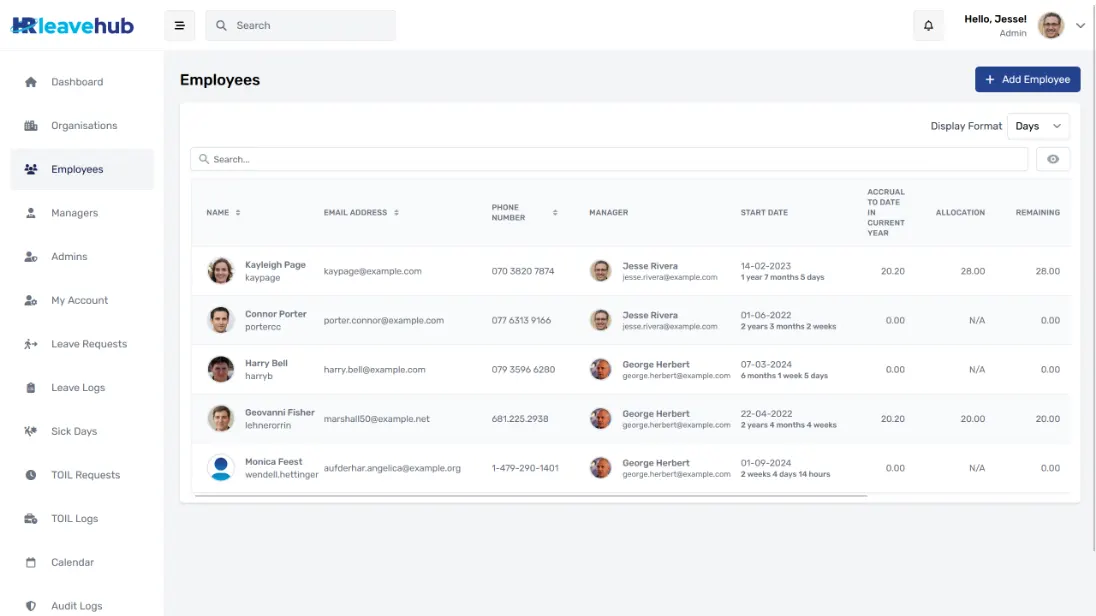Leave management software is a digital tool that automates and centralises the process of tracking, approving and managing employee time off.
Employers still rely on outdated methods, like spreadsheets, email chains, or manual forms, and face avoidable risks. These systems create delays, introduce errors, and offer little visibility or control. More importantly, they make compliance with region-specific employment laws harder to maintain.
In contrast, using employee leave management software streamlines the entire process. It reduces admin time, ensures accurate records, and improves workforce planning. It also helps employers stay legally compliant without constant manual oversight.
This article outlines five challenges employers face without proper leave management systems and why switching to a purpose-built solution is not only efficient but essential.
1. Poor Absence Visibility and Inaccurate Records
Without leave management software, employers often lack real-time visibility into staff absences. This leads to inaccurate leave records and poor workforce planning. When absence data is scattered across spreadsheets, emails, and manual forms, there’s no reliable way to track who is off, when, or for what reason.
Relying on outdated time off logs or inconsistent employee leave tracking methods confuses teams. Managers may approve overlapping leave by mistake or overlook key entitlements, leading to overstaffing in quiet periods or understaffing during peak demand. These gaps directly affect productivity and service delivery.
Without a structured employee leave tracker, absenteeism can escalate unnoticed. Without a system to flag patterns early, recurring short-term absences often slip through the cracks.
A dedicated staff leave planner or time off tracker gives employers a real-time overview of leave data. Improving accuracy, ensuring fair leave allocation, and helping the team plan resources confidently.
2. Increased Risk of Non-Compliance with Leave Policies
Manual leave tracking often leads to outdated or inconsistent leave policy practices across departments or locations. Employers struggle to apply the correct entitlements and procedures without structured systems, especially when managing teams in different regions with varying legal requirements.
Mismanaging annual leave entitlements, sick leave, or parental leave puts employers at risk of breaching statutory rules. Without tools like a holiday entitlement calculator or automated rule checks, HR teams rely on guesswork or outdated HR documentation, increasing the chance of errors.
These mistakes can lead to fines, disputes, or audits, each carrying legal, financial, and reputational consequences. Inconsistent policy application can also create claims of unfair treatment or discrimination.
HR compliance software ensures accurate leave policy management and creates secure audit trails. Centralising policies across the organisation reduces compliance risks and gives employers confidence that statutory requirements are being met in every location.
3. Reduced Productivity Due to Scheduling Conflicts and Overlaps
Without a central system, overlapping leave approvals and poor visibility into staff availability are common. This leads to scheduling conflicts, uneven workloads, and critical staffing gaps, especially during busy periods.
Teams are often left short-staffed at key moments because managers approve leave without seeing the full picture. Planning becomes reactive instead of proactive, directly impacting productivity and delivery timelines. For example, two senior staff members might be approved for time off during a major project, or unplanned absences could clash with deadline-driven tasks.
The absence of employee scheduling software or a staff leave planner makes aligning leave with operational needs difficult. Employers can’t answer questions like “Who is available next week?” or “Can we meet this deadline with reduced staff?”
Using online employee scheduling software with built-in workforce planning tools gives managers the foresight to make better decisions. It ensures proper coverage, balances workloads, and keeps projects on track with core goals in effective workforce planning.
4. Increased Administrative Burden on HR Teams
Without a dedicated HR leave system, HR teams spend excessive time on repetitive tasks—updating spreadsheets, chasing approvals by email, and manually logging absence records. These outdated methods slow down processes and drain resources across the organisation.
Manual leave tracking often involves multiple people in approval chains, causing delays, miscommunication, and missed requests. It’s not uncommon for mid-sized organisations to spend 20–30 hours per month managing leave manually; time which could be used more strategically.
These processes are prone to human error. Overlapping leave approvals, double bookings, or incorrect entitlements create more work for HR managers and damage employee trust.
By adopting HR automation and digital leave workflows, teams streamline absence request handling from submission to approval. An innovative HR leave system reduces admin burden, eliminates error-prone tasks, and frees HR professionals to focus on strategy, compliance, and workforce planning.
5. Negative Impact on Employee Experience and Trust
Unclear or slow leave processes damage the employee experience. When staff don’t know how much leave they have or whether their request was approved, frustration builds quickly. Common complaints include: “I don’t know how much leave I have left,” or “My request disappeared—no one replied.”
Without proper employee leave management, records are often outdated, requests go unanswered, and staff leave policies are applied inconsistently. This lack of transparency leads to confusion and resentment. When employees feel treated unfairly or left out of the loop, they lose trust in both HR and leadership.
Digital tools like a time off manager or self-service HR portal empower staff to check balances, request leave, and track approvals independently. These systems reinforce fairness, promote transparency, and help build a workplace culture where people feel respected and informed.
In the long run, better systems lead to higher trust, improved retention, and a more engaged workforce.
How These Challenges Add Up Over Time
Individually, each of these issues may seem minor, but over time, they compound into significant operational strain. Small errors in leave tracking can snowball into payroll discrepancies, scheduling conflicts, and costly compliance risks. Manual systems leave gaps in data, slow down HR admin processes, and increase the chance of miscommunication across teams.
Ongoing inefficiencies affect more than just HR; they impact business-wide productivity, disrupt project timelines, and lower employee morale. Unaddressed absenteeism, poor staff scheduling, and inconsistent policies gradually erode trust and performance.
When employers lack HR automation, they spend more time fixing preventable problems than focusing on strategic goals. Investing in a structured, compliant system like HR LeaveHub helps resolve all five challenges simultaneously, creating clarity, saving time, and reducing long-term costs.
Explore how leave management software transforms how your organisation manages people, policies, and performance.
Final Thoughts: Leave Management Software Is Not Just a ‘Nice to Have’
Employers face a growing list of avoidable problems without proper leave management software, such as disorganised processes, compliance risks, poor visibility, and rising admin workloads. These challenges don’t just stay in HR. They affect business operations, employee satisfaction, and overall organisational efficiency.
Manual systems are no longer suitable for modern workplaces. With increasing legal obligations and complex workforce needs, relying on outdated tools limits performance and increases long-term risk.
Tools like HR LeaveHub are built to help HR teams avoid these common pitfalls—streamlining leave tracking, supporting compliance, and improving the experience for both employers and employees.
Register today and get a 14-day free trial.







